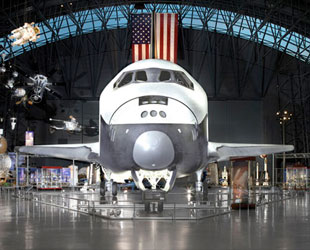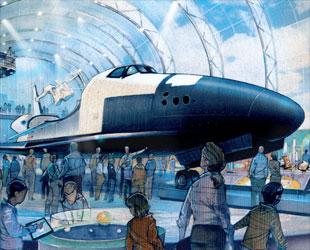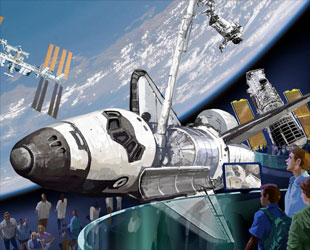April 12, 2011 — NASA filed the final flight plans for its three retiring space shuttles on Tuesday, assigning two to museums in Washington, DC and California, and keeping the third at its launch and landing site in Florida. A fourth, prototype orbiter will also go to a new home in New York.
NASA Administrator Charles Bolden announced the long awaited news during an employee event held at Kennedy commemorating the 30th anniversary of the space shuttle program. STS-1, the maiden flight for the winged reusable spaceship fleet, lifted off on April 12, 1981.
"Each shuttle has stories to be told, history to be shared," said Bolden. "We intend to tell their stories and share that history with as many people as we can over the coming years and decades."
"People from across our nation and around the world will continue to learn from these amazing vehicles and the stories of their crews and their missions. The shuttles will inspire many people who are now just in school to become the next generation of exploration leaders and millions more who are just proud and passionate about our space program will also now have a chance to see a space shuttle in-person," Bolden said.
His announcement means that NASA space shuttles will eventually go on display on both coasts of the U.S., with three along the East Coast.
Space shuttle Discovery, NASA's oldest remaining orbiter and the world's most flown spacecraft, will be displayed by the Smithsonian's National Air and Space Museum at its Steven F. Udvar-Hazy Center near Dulles International Airport.

The atmospheric test orbiter Enterprise will be replaced by the shuttle Discovery at the Smithsonian's Udvar-Hazy Center. |
The shuttle Endeavour, which will launch on its own final mission later this month, will be given to the California Science Center, a department of the State of California, in Los Angeles.
"The California Science Center in Los Angeles [is] only a few miles from the site of the old Rockwell plant where the shuttle was developed and from where its construction was managed," said Bolden.
Shuttle Atlantis will remain in Florida to be exhibited at the spaceport's official visitor complex after launching on the 135th and last mission of NASA's shuttle program in late June.
"The Kennedy Space Center, where every shuttle mission and so many other historic space flights have originated, will showcase my old friend Atlantis," stated Bolden, who as an astronaut flew one of his four missions on Atlantis.
"Not only will the workers who sent it into space so many times have a chance to still see it, the millions of visitors who come here every year to learn more about space and be a part of the excitement of exploration will be able to see what is still a great rarity, an actual flown space vehicle."
Bolden also announced that the atmospheric test orbiter Enterprise, which has belonged to the Smithsonian since 1982 and has been on display at the Udvar-Hazy Center since 2003, will be transferred to the Intrepid Sea, Air and Space Museum, a converted aircraft carrier docked to a pier in New York City, to make way for Discovery to enter the national collection.
Showcasing the shuttles
At present, NASA plans to have the shuttles ready to ship to their museums by early- to mid-next year.
For those going to sites outside of Florida, the orbiters will be attached to the back of NASA's modified Boeing 747 airliner and ferried to their new homes. Cranes will offload the shuttles from the carrier aircraft at the recipient cities' airports and then, depending on the location, the orbiters will be further moved to their display buildings.
At the National Air and Space Museum's Udvar-Hazy just outside Washington, DC, Discovery will be rolled into the James S. McDonnell Space Hangar, where it will serve as the centerpiece for an exhibit hall already filled with other historic space artifacts.
As Discovery moves in, Enterprise will be shipped up the coast to the Intrepid in New York. Too large to fit on the deck of the aircraft carrier and still have room for the other aircraft already on display, Enterprise will be housed in a planned glass-enclosed hangar that will sit alongside the Intrepid on Pier 86, where the museum's Concorde jet sits now. According to an artist's concept drawings, Enterprise will be displayed with its payload bay open, surrounded by interactive educational exhibits.

The Intrepid Sea, Air and Space Museum plans to display the prototype orbiter Enterprise in a new glass-enclosed hangar. |
Endeavour will be sent west, joining the space exhibits at the California Science Center, where Mercury, Gemini and Apollo spacecraft are already on display. Unlike the other museums selected, the science center did not pre-release its exhibit design concepts for the orbiter.
At the Kennedy Space Center Visitor Complex in Florida, Atlantis will be suspended such that it appears to be back in orbit around the Earth. As proposed, a multi-story digital projection of the home planet will rotate behind the orbiter in a new $100 million, 64,000 square-foot indoor facility.
Kennedy's display is designed to complement its existing Shuttle Launch Experience, which opened in 2007 to give visitors the chance to feel what it was like to ride to space aboard one of the orbiters.

An artist rendition of Kennedy Space Center's plans for a $100 million, 64,000 sq. foot exhibit hall for space shuttle Atlantis. |
"I want to congratulate all of these fine institutions and wish them many visitors and exciting programs with the space shuttle fleet. For all of them, take good care of our vehicles. They've served the nation well, and we at NASA have a deep and abiding relationship and love affair with them that is hard to put into words," Bolden said.
More suitors than shuttles
Bolden's announcement Tuesday came three years after NASA first said it would give its retired space shuttles to U.S. museums or educational institutions. Solicitations in 2008 and then again last year identified 21 organizations vying for an orbiter.
Museums needed to provide an environmentally-controlled indoor exhibit space and be able to afford the estimated $28.8 million needed to prepare the orbiter and transport it for display (Congress waived the fee for the Smithsonian).
"There were many many worthy institutions that requested an orbiter and only four to go around," said Bolden.
In addition to those selected, other candidates seen as leading contenders included Space Center Houston, the official visitor center for NASA's Johnson Space Center in Texas; the Adler Planetarium in Chicago, Illinois; and the U.S. Space and Rocket Center, the museum for NASA's Marshall Space Flight Center in Huntsville, Alabama.
Two of the candidates that were ultimately not chosen for an orbiter had already raised significant funds and in one case, begun construction, for new shuttle-sized buildings.
The National Museum of the U.S. Air Force in Dayton, Ohio raised $5 million from the Boeing Company and was pledged an additional $14 million in President Obama's fiscal year 2012 budget request to display a shuttle there.
And The Museum of Flight in Seattle, Washington, broke ground last June on a $12 million Space Shuttle Gallery, which is on schedule to be completed this fall.
Both museums will receive shuttle simulators or mockups that were used to train the astronauts.
"Many of the applicant institutions who did not receive an orbiter will receive significant space shuttle hardware and artifacts to help bring to life this dynamic chapter of our nation's space exploration history for their many visitors," Bolden said.
End of an era
The decision to retire the space shuttles came in the wake of the 2003 loss of orbiter Columbia, NASA's first shuttle to fly in space, as it returned to Earth on its 28th mission. NASA lost the space shuttle Challenger, its second orbiter to fly, on an earlier flight in 1986 when that orbiter broke apart 73 seconds into its 10th launch.
Having completed the International Space Station (ISS) and serviced the Hubble Space Telescope for a fifth and final time, the shuttles are going away in favor of using commercially-operated vehicles for access to low Earth orbit and a larger, Apollo-like capsule for flights to an asteroid and other destinations further out into the solar system.
NASA will rely on Russia's Soyuz spacecraft to bring its astronauts to and from the ISS until those new vehicles are ready, targeted for 2016 or earlier.
The space shuttle was the world's first reusable crewed space vehicle and the first to launch like a rocket, orbit like a spacecraft and return to Earth like a glider. Over the course of their combined three decades in service, the five space-worthy orbiters launched more than 350 people from close to 20 nations.
